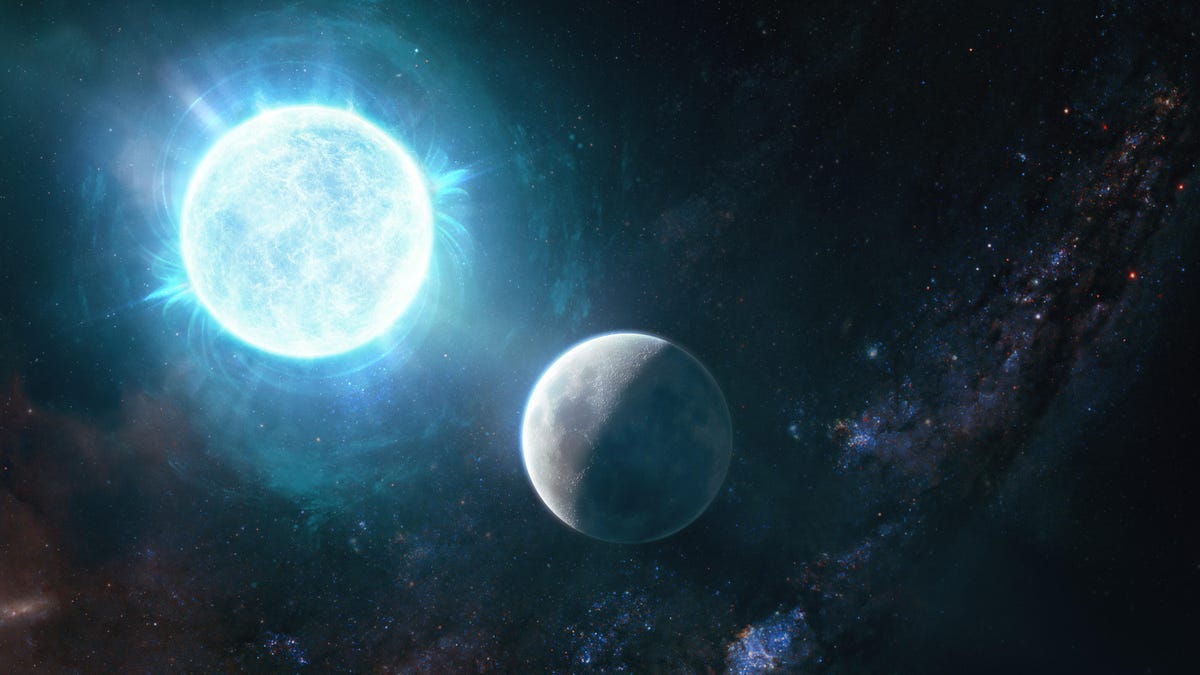Astronomers just found a star as small as the moon but more massive than the sun
And it could be on the verge of collapsing into a neutron star.

This illustration places the newly found white dwarf star right next to our moon for size comparison.
What's slightly larger than our moon but almost 1.4 times more massive than our sun? ZTF J1901+1458, one of the smallest white dwarf stars ever spotted by astronomers. The dying husk of a sun-like star was spotted relatively close by, just 133 light-years away, by a series of ground- and space-based telescopes.
In a study published in the journal Nature on Wednesday, researchers detail the discovery and characteristics of ZTF J1901+1458, which is so named because it was spotted by the Zwicky Transient Facility, a sky survey using the Palomar Observatory in California that searches space for any objects with sudden changes in brightness. It's quite an extreme star.
White dwarfs are formed when stars about eight times the mass of our sun or smaller come to the end of their lives. As they run out of fuel, they begin to collapse -- but somewhat paradoxically, this initial collapse causes the star to swell to monstrous sizes and become a red giant (like the famous star Betelgeuse).
This process also sees the star cool down a little and its core contract, which releases a huge amount of energy, again making it bigger. However, it starts to lose its outer layers and leave behind just an extremely dense core. A white dwarf.
That's what the research team saw in the ZTF data: the husk of a blown-out star. To get a better handle on its characteristics, they used data collected by the European Space Agency's Gaia satellite, the Keck telescope in Hawaii and NASA's Swift observatory. Once they'd analyzed J1901+1458, they realized it something special: It was rotating extremely quickly and appeared to be almost as massive as a white dwarf can get.
The team believe the white dwarf was originally two stars that danced with each other for billions of years. They both evolved to become white dwarfs, before finally merging and creating the new, much more massive star.
"We caught this very interesting object that wasn't quite massive enough to explode," said Ilaria Caiazzo, an astrophysicist at Caltech and lead author of the new study, in a press release. "We are truly probing how massive a white dwarf can be."
It has also been described as the smallest white dwarf discovered, but that title might go to another object believed to be a white dwarf, known as RX J0648.0–4418.
So what will happen to the white dwarf now?
"This is highly speculative, but it's possible that the white dwarf is massive enough to further collapse into a neutron star," said Caiazzo. Usually neutron stars form when huge stars collapse, but it's speculated that about one in 10 might be formed from the collapse of a white dwarf.
That's because weird things are happening in the super-dense core of a white dwarf. Caiazzo describes a process at the subatomic scale, where electrons are being captured and forming neutrons. As more and more electrons are removed, the core gets closer to collapse and ultimately ends up as a "zombie" neutron star, one of the most unusual and mysterious cosmic bodies in the universe.
"There are so many questions to address," notes Caiazzo.

